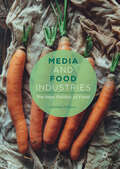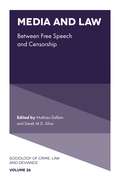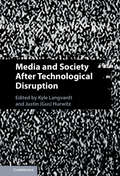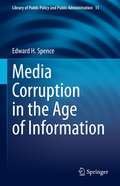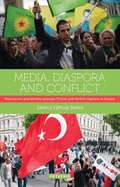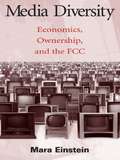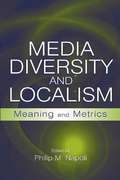- Table View
- List View
Mechanisms to Enable Follow-On Innovation: Liability Rules vs. Open Innovation Models (Munich Studies on Innovation and Competition #15)
by Alina WernickThe patent system is based on "one-patent-per-product" presumption and therefore fails to sustain complex follow-on innovations that contain a number of patents. The book explains that follow-on innovations may be subject to market failures such as hold-ups and excessive royalties. For decades, scholars have debated whether the market problems can be solved with voluntary licensing i.e., open innovation, or with compulsory liability rules. The book concludes that neither approach is sufficient. On the one hand, incentives to engage in open innovation practices involving patents are insufficient. On the other hand, the existing compulsory liability rules in patent and competition law are not tailored to address follow-on innovator's interests. To transcend this problem, the author proposes a compulsory liability rule against the suppression of follow-on innovation, that paradoxically, fosters early-on voluntary licensing between patent holders and follow-on innovators. The book is aimed at patent and competition law scholars and practitioners, patent attorneys, managers, engineers and economists who either engage in open innovation involving patents or conduct research on the topic. It also offers insights to policy and law-makers reviewing the possibilities to foster open innovation initiatives or adapt the scope of patent remedies or employ compulsory licenses for patents.
The Media and Business Contracts Handbook
by Adrian C Laing Deborah FosbrookProvides the tools for the user to construct a contract in a logical format and draft the terms in language that both parties can easily understand and put into practice and the accompanying digital download reduces administration time in the office.The book has a number of functions:1. As a starting point and framework for an agreement.2. To compare and analyse other contracts you are working on.3. As a background guide and training tool.4. As a reference tool for websites and trade codes of practice.5. The commentaries can be read as guides to the intended aims of a specific contract.6. The checklist of clauses can be used to ensure you have covered important issues.7. To achieve a clearer understanding of a transaction.
Media and Communications Policy Making: Processes, Dynamics and International Variations (Palgrave Global Media Policy and Business)
by Robert G. PicardThis textbook focuses on how media and communications policy is made and what influences its design. It explores the structures and processes in which policymaking takes place worldwide, the factors that determine its forms, influence its elements, and affect its outcomes. It explores how to analyze policy proposals, evaluate policy, and use policy studies approaches to examine policy and policymaking. Truly international in scope, it lays out the variety of political, social, economic, and institutional influences on policy, the roles of industries and policy advocates in the processes, and issues and factors that complicate effective policymaking and skew policy outcomes. This textbook is a valuable resource for advanced undergraduate and postgraduate students.
Media and Food Industries: The New Politics of Food
by Michelle PhillipovThis volume is the first to combine textual analysis of food media texts with interviews with media production staff, reality TV contestants, celebrity chefs, and food producers and retailers across the artisan-conventional spectrum. Intensified media interest in food has seen food politics become a dominant feature of popular media—from television and social media to cookbooks and advertising. This is often thought to be driven by consumers and by new ethics of consumption, but Media and Food Industries reveals how contemporary food politics is also being shaped by political and economic imperatives within the media and food industries. It explores the behind-the-scenes production dynamics of contemporary food media to assess the roles of—and relationships between—media and food industries in shaping new concerns and meanings with respect to food.
Media and Law: Between Free Speech and Censorship (Sociology of Crime, Law and Deviance #26)
by Mathieu Deflem Derek M. D. SilvaIn Media and Law: Between Free Speech and Censorship, Mathieu Deflem and Derek M.D Silva have gathered an interdisciplinary team of leading experts to make a valuable contribution to the existing literature. This volume explores free speech and the control thereof from both a political as well as cultural lens. These topics have once again moved center stage in scholarly as well as popular discussions on what must, should, and should not be said in the public sphere of ideas, opinions, and tastes. In a world of alternative facts, fake news, gender politics, company self-censorship, edited art, hate speech, and career-ending tweets, the chapters in this volume make a timely contribution.
Media and Law: Between Free Speech and Censorship (Sociology of Crime, Law and Deviance #26)
by Mathieu Deflem and Derek M. D. SilvaIn Media and Law: Between Free Speech and Censorship, Mathieu Deflem and Derek M.D Silva have gathered an interdisciplinary team of leading experts to make a valuable contribution to the existing literature. This volume explores free speech and the control thereof from both a political as well as cultural lens. These topics have once again moved center stage in scholarly as well as popular discussions on what must, should, and should not be said in the public sphere of ideas, opinions, and tastes. In a world of alternative facts, fake news, gender politics, company self-censorship, edited art, hate speech, and career-ending tweets, the chapters in this volume make a timely contribution.
Media and Peace in the Middle East: The Role of Journalism in Israel-palestine (PDF)
by G. TiripelliIn exploring the dynamics and narratives of peace in journalism, this book explains the media's impact on the transformation of the conflict between Israelis and Palestinians. It discusses the perspectives of peace activists who have been involved in grassroots action since the first Intifada, and examines how their relation with the mainstream media has evolved over time. It compares these views with those of professional journalists who have been covering the conflict, and their sense of the difficulties inherent in practicing a different kind of journalism. The interviews included in this study contribute towards the model of Peace Journalism, with a view to facilitating its successful application to this conflict.
Media and Society After Technological Disruption
by Kyle Langvardt Gus HurwitzThe internet has reshaped the media landscape and the social institutions built upon it. Competition from online media sources has decimated local journalism and diminished the twentieth century's established journalistic gatekeepers. Social media puts individual users front and center in the creation of the content that they consume. Harmful speech can spread further and faster, and the institutions responsible for policing that speech-Facebook, TikTok, YouTube and the like-lack any clear twentieth-century analog. The law is still working to catch up to the world these changes have wrought. This volume gathers sixteen scholars in law, media, technology, and history to consider these changes. Chapters explore the breakdown of trust in the media, changes in the law of defamation and privacy, challenges of online content moderation, and financial viability for journalistic enterprises in the internet age. This title is also available as Open Access on Cambridge Core.
The Media and the Military
by P. Young P. JesserThe first comprehensive study of the contentious issue of the public's right to know in time of war or limited conflict. The book traces the uneasy relations between the military and a generally unprepared and gullible media, from the Crimea to the present day. It shows how the advent of nuclear warfare has outlawed the nationalistic wars of survival of the past, and freed the citizen from his age-old obligations in time of war, able to make up his or her own mind on the merits of the situation. It is here that the battle lies, in the struggle for public opinion as a necessary precursor to war. This book details how the military discovered the secret of media and public manipulation in the Falklands, tested it in Grenada, and refined it in Panama before deploying it in all its glory during the Gulf. This book is essential reading for every soldier and journalist, or any student of military history as it points the way to the future.
Media Corruption in the Age of Information (Library of Public Policy and Public Administration #15)
by Edward H. SpenceThis book provides an applied model of corruption to identify, analyse, and assess the ethics of major types of corruption in the media involving practices such as cash-for-comment, media release journalism, including video news releases (VNRs), fake news, deep fakes, and staged news. The book starts with a conceptual philosophical analysis of corruption in general, followed by an in-depth analysis of media corruption, across its various transformations, from the legacy media of the 4th Estate (e.g. The UK Guardian) to the digital media of the 5th Estate (e.g. Social Media and Wikileaks) to the Network Media of the 6th Estate (e.g. Facebook and Google), and provides key case studies as practical illustrations and contextualisation of those major types of media corruption. It explains how the conversion of the two forms of media communication, corporate and social digital communication, as expressed in the symbiotic relationship between the 4th Estate and the 5th Estate exposes and enables the reporting of corruption, signalling a major shift in the way the media itself can provide an effective means for anti-corruption measures against major practices of corruption that would have otherwise gone unnoticed.
Media, Development and Democracy (Studies in Media and Communications #22)
by Heloisa Pait, Juliana LaetSponsored by the Communication, Information Technologies, and Media Sociology section of the American Sociological Association (CITAMS), this book explores the complex construction of democratic public dialogue in developing countries. Case studies examine national environments defined not only by state censorship and commercial pressure, but also language differences, international influence, social divisions, and distinct value systems. With fresh portraits of new and traditional media throughout Africa, Latin America and Asia, authors delve into the essential role of the media in developing countries. Case studies illuminate the relationship between the State and the media in Russia, as well as the challenges faced by journalists working in Kurdistan. Further cases reveal bureaucratic censorship of books in Brazil, regulatory dilemmas in Australia, state policies in post-colonial Malawi, and the potential of oral culture for the strengthening of democratic conversation. Media, Development and Democracy brings the liberal democratic media model into new terrains where some of its core assumptions do not hold. In doing so, the authors' collective voices illuminate pressing issues facing our current global dialogue and our liberal and democratic expectations concerning communications and the media. This essential volume works as a magnifying glass for our current times, forcing us to question what kind of media we want today
Media, Development and Democracy (Studies in Media and Communications #22)
by Heloisa Pait Juliana LaetSponsored by the Communication, Information Technologies, and Media Sociology section of the American Sociological Association (CITAMS), this book explores the complex construction of democratic public dialogue in developing countries. Case studies examine national environments defined not only by state censorship and commercial pressure, but also language differences, international influence, social divisions, and distinct value systems. With fresh portraits of new and traditional media throughout Africa, Latin America and Asia, authors delve into the essential role of the media in developing countries. Case studies illuminate the relationship between the State and the media in Russia, as well as the challenges faced by journalists working in Kurdistan. Further cases reveal bureaucratic censorship of books in Brazil, regulatory dilemmas in Australia, state policies in post-colonial Malawi, and the potential of oral culture for the strengthening of democratic conversation. Media, Development and Democracy brings the liberal democratic media model into new terrains where some of its core assumptions do not hold. In doing so, the authors' collective voices illuminate pressing issues facing our current global dialogue and our liberal and democratic expectations concerning communications and the media. This essential volume works as a magnifying glass for our current times, forcing us to question what kind of media we want today
Media, Diaspora and Conflict: Nationalism and Identity amongst Turkish and Kurdish Migrants in Europe (International Library of Migration Studies)
by Janroj Yilmaz KelesFor migrant communities residing outside of their home countries, various transnational media have played a key role in maintaining, reviving and transforming ethnic and religious identities. A vital element is how media outlets report and represent ethno-national conflict in the home country. Janroj Yilmaz Keles here examines how this plays out among Kurdish and Turkish communities in Europe. He offers an analysis of how Turkish and Kurdish migrants in Europe react to the myriad mediated narratives. A vital element is how media outlets report and represent the ethno-national conflict between the Turkish state and the Kurdish PKK.Janroj Yilmaz Keles here offers an examination of how Turkish and Kurdish migrants in Europe react to the myriad narratives that arise. Taking as his starting point an analysis of the nature of nationalisms in the modern age, Keles shows how language is often a central element in the struggle for hegemony within a state. The media has become a site for the clash of representations in both Turkish and Kurdish languages, especially for those based in the diaspora in Europe. These 'virtual communities', connected by television and the internet, in turn influence and are influenced by the way the conflict between the Turkish state and subaltern Kurds is played out, both in the media and on the ground.By looking at first, second and third generations of Turkish and Kurdish populations in Europe, Keles highlights the dynamics of migration, settlement and integration that often depend on the policies of each settlement country. Since these settlement states often see the proliferation of such media as an impediment to integration, Media, Diaspora and Conflict offers timely analysis concerning the nature of diasporas and the construction of identity.
Media Diversity: Economics, Ownership, and the Fcc (Routledge Communication Series)
by Mara EinsteinMedia Diversity: Economics, Ownership, and the FCC provides a detailed analysis of the regulation of diversity and its impact on the structure and practices within the broadcast television industry. As deregulation is quickly changing the media landscape, this volume puts the changing structure of the industry into perspective through the use of an insider's point of view to examine how policy and programming get made. Author Mara Einstein blends her industry experience and academic expertise to examine diversity as a media policy, suggesting that it has been ineffective and is potentially outdated, as study after study has found diversity regulations to be wanting. In addition to reviewing diversity research on the impact of minority ownership, regulation of cable and DBS, duopolies, ownership of multiple networks and cross ownership of media on program content, Einstein considers the financial interest and syndication rules as a case study, due to their profound effects on the structure of the television industry. She also poses questions from an economic perspective on why the FCC regulates structure rather than content. Through the presentation of her research results, she argues persuasively that the consolidation of the media industry does not affect the diversity of entertainment programming, a conclusion with broad ramifications for all media and for future research about media monopolies. This volume serves as a defining work in its examination of the intersection of regulation and economics with media content. It is appropriate as a supplemental text in courses on communication policy, broadcast economic and media management, broadcast programming, political economy of the mass media, and media criticism at the advanced and graduate level. It is also likely to interest broadcast professionals, media policymakers, communication lawyers, and academics. It is a must-read for all who are interested in the media monopoly debate.
Media Diversity: Economics, Ownership, and the Fcc (Routledge Communication Series)
by Mara EinsteinMedia Diversity: Economics, Ownership, and the FCC provides a detailed analysis of the regulation of diversity and its impact on the structure and practices within the broadcast television industry. As deregulation is quickly changing the media landscape, this volume puts the changing structure of the industry into perspective through the use of an insider's point of view to examine how policy and programming get made. Author Mara Einstein blends her industry experience and academic expertise to examine diversity as a media policy, suggesting that it has been ineffective and is potentially outdated, as study after study has found diversity regulations to be wanting. In addition to reviewing diversity research on the impact of minority ownership, regulation of cable and DBS, duopolies, ownership of multiple networks and cross ownership of media on program content, Einstein considers the financial interest and syndication rules as a case study, due to their profound effects on the structure of the television industry. She also poses questions from an economic perspective on why the FCC regulates structure rather than content. Through the presentation of her research results, she argues persuasively that the consolidation of the media industry does not affect the diversity of entertainment programming, a conclusion with broad ramifications for all media and for future research about media monopolies. This volume serves as a defining work in its examination of the intersection of regulation and economics with media content. It is appropriate as a supplemental text in courses on communication policy, broadcast economic and media management, broadcast programming, political economy of the mass media, and media criticism at the advanced and graduate level. It is also likely to interest broadcast professionals, media policymakers, communication lawyers, and academics. It is a must-read for all who are interested in the media monopoly debate.
Media Diversity and Localism: Meaning and Metrics (Routledge Communication Series)
by Philip M. NapoliQuestions concerning the quality of media performance and the effectiveness of media policymaking often revolve around the extent to which the media system fulfills the values inherent in diversity and localism principles. This edited volume addresses challenges and issues relating to diversity in local media markets from a media law and policy perspective. Editor Philip M. Napoli provides a conceptual and empirical framework for assessing the success/failure of media markets and media outlets in fulfilling diversity and localism objectives. Featuring well-known contributors from a variety of disciplines, including media, law, political science, and economics, Media Diversity and Localism explores the following topics:*media ownership and media diversity and localism;*conceptual and methodological issues in assessing media diversity and localism;*minorities, media, and diversity; and*contextualizing media diversity and localism: audience behavior and new technologies. This substantive and timely volume speaks to scholars and researchers in the areas of media law and policy, political science, and all others interested in media regulation. It can also be used in a graduate seminar on media policy topics.
Media Diversity and Localism: Meaning and Metrics (Routledge Communication Series)
by Philip M. NapoliQuestions concerning the quality of media performance and the effectiveness of media policymaking often revolve around the extent to which the media system fulfills the values inherent in diversity and localism principles. This edited volume addresses challenges and issues relating to diversity in local media markets from a media law and policy perspective. Editor Philip M. Napoli provides a conceptual and empirical framework for assessing the success/failure of media markets and media outlets in fulfilling diversity and localism objectives. Featuring well-known contributors from a variety of disciplines, including media, law, political science, and economics, Media Diversity and Localism explores the following topics:*media ownership and media diversity and localism;*conceptual and methodological issues in assessing media diversity and localism;*minorities, media, and diversity; and*contextualizing media diversity and localism: audience behavior and new technologies. This substantive and timely volume speaks to scholars and researchers in the areas of media law and policy, political science, and all others interested in media regulation. It can also be used in a graduate seminar on media policy topics.
Media & Entertainment Law
by Ursula SmarttMedia & Entertainment Law presents a contemporary analysis of the law relating to the media and entertainment industries both in terms of its practical application and its theoretical framework, providing a broad and comprehensive coverage of these fast changing branches of the law. Fully restructured to complement how media law is taught today in the digital age, this third edition explores recent updates in the law including the outcomes of the Google Spain case and the ‘right to be forgotten’, the use of drones in breach of privacy laws, internet libel and the boundaries of media freedom and press regulation following the Leveson inquiry. Media & Entertainment Law uses the most up-to-date authorities to explore privacy and confidentiality subjects, such as the Prince Charles 'black spider' letters, the Maximilian Schrems and the celebrity superinjunction PJS v Newsgroup Newspapers cases. The book also covers defamation, contempt of court and freedom of information, plus Scots law. New to this edition: A brand new chapter is dedicated to exploring technology and the media, including contemporary issues such as the dark web, the surveillance state, internet censorship and the law and social media, including bloggers, vloggers and tweeters. The chapters on regulatory authorities have been expanded to provide greater clarification and explanation of broadcasting, press and advertising regulation, including the protection of journalistic sources and comparisons with EU Law. The chapter on intellectual property and entertainment law has been streamlined to match media law courses more effectively. This text provides students with detailed coverage of the key principles, cases and legislation as well as a critical analysis of this vibrant subject.
Media & Entertainment Law
by Ursula SmarttMedia & Entertainment Law presents a contemporary analysis of the law relating to the media and entertainment industries both in terms of its practical application and its theoretical framework, providing a broad and comprehensive coverage of these fast changing branches of the law. Fully restructured to complement how media law is taught today in the digital age, this third edition explores recent updates in the law including the outcomes of the Google Spain case and the ‘right to be forgotten’, the use of drones in breach of privacy laws, internet libel and the boundaries of media freedom and press regulation following the Leveson inquiry. Media & Entertainment Law uses the most up-to-date authorities to explore privacy and confidentiality subjects, such as the Prince Charles 'black spider' letters, the Maximilian Schrems and the celebrity superinjunction PJS v Newsgroup Newspapers cases. The book also covers defamation, contempt of court and freedom of information, plus Scots law. New to this edition: A brand new chapter is dedicated to exploring technology and the media, including contemporary issues such as the dark web, the surveillance state, internet censorship and the law and social media, including bloggers, vloggers and tweeters. The chapters on regulatory authorities have been expanded to provide greater clarification and explanation of broadcasting, press and advertising regulation, including the protection of journalistic sources and comparisons with EU Law. The chapter on intellectual property and entertainment law has been streamlined to match media law courses more effectively. This text provides students with detailed coverage of the key principles, cases and legislation as well as a critical analysis of this vibrant subject.
Media & Entertainment Law
by Ursula SmarttThe fourth edition of Media and Entertainment Law has been fully updated, analysing some of the most recent judgments in media law from across the United Kingdom, such as Cliff Richard v the BBC, Max Schrems v Facebook and the Irish Information Commissioner, developments on the ‘right to be forgotten’ (NT1 and NT2) and ABC v Daily Telegraph (Sir Philip Green). The book’s two main themes are freedom of expression and an individual’s right to privacy. Regulation of the communication industries is covered extensively, including discussion of the print press and its online editions following Leveson, traditional broadcasting regulations for terrestrial TV and radio as well as media activities on converged devices, such as tablets, iPads, mobile phone devices and ‘on demand’ services. Intellectual property law (specifically copyright) in the music and entertainment industries is also explored in the book’s later chapters. Also new to this edition are sections on: A focus on freedom of expression: its philosophical foundations; the struggles of those who have fought for it; and the varied ways in which the courts interpret freedom of expression regarding the taking and publishing of photographs. The ‘right to be forgotten’, data breaches, and the General Data Protection Regulation (GDPR). The media’s increasing access to the courts, particularly when considering the privacy of those who are suspected of sexual offences. Press regulators, broadcasting and advertising regulations, and film and video regulations. Election and party-political broadcast regulations, with a focus on social media and recent election fraud. The emergence of online music distribution services, internet radio and free digital streaming music services, and their effect on the music industry. The fourth edition also features a variety of pedagogical features to encourage critical analysis of case law and one’s own beliefs.
Media & Entertainment Law
by Ursula SmarttThe fourth edition of Media and Entertainment Law has been fully updated, analysing some of the most recent judgments in media law from across the United Kingdom, such as Cliff Richard v the BBC, Max Schrems v Facebook and the Irish Information Commissioner, developments on the ‘right to be forgotten’ (NT1 and NT2) and ABC v Daily Telegraph (Sir Philip Green). The book’s two main themes are freedom of expression and an individual’s right to privacy. Regulation of the communication industries is covered extensively, including discussion of the print press and its online editions following Leveson, traditional broadcasting regulations for terrestrial TV and radio as well as media activities on converged devices, such as tablets, iPads, mobile phone devices and ‘on demand’ services. Intellectual property law (specifically copyright) in the music and entertainment industries is also explored in the book’s later chapters. Also new to this edition are sections on: A focus on freedom of expression: its philosophical foundations; the struggles of those who have fought for it; and the varied ways in which the courts interpret freedom of expression regarding the taking and publishing of photographs. The ‘right to be forgotten’, data breaches, and the General Data Protection Regulation (GDPR). The media’s increasing access to the courts, particularly when considering the privacy of those who are suspected of sexual offences. Press regulators, broadcasting and advertising regulations, and film and video regulations. Election and party-political broadcast regulations, with a focus on social media and recent election fraud. The emergence of online music distribution services, internet radio and free digital streaming music services, and their effect on the music industry. The fourth edition also features a variety of pedagogical features to encourage critical analysis of case law and one’s own beliefs.
Media & Entertainment Law
by Ursula SmarttNow in its fifth edition, this textbook combines comprehensive coverage with rigorous analysis of a key area of the law. The author illuminates how the courts strive to strike a balance between the freedoms and responsibilities of the press on the one hand and an individual’s right to privacy on the other. Maintaining its coverage of the law across the UK (including Scotland and Northern Ireland) and the EU, the new edition has been brought up to date with expert insights into significant developments and judgments, including: the impact of changes in intellectual property law, data protection, GDPR and copyright law post Brexit – including the cases of Schrems II and Ed Sheeran; analysis of new case law and developments in privacy and freedom of the media – including Duchess of Sussex (Meghan Markle) v The Mail on Sunday and ZXC v Bloomberg; the introduction of new Scottish defamation laws and the importance of defamatory meaning; the response to disinformation, fake news and social media – including tweeting jurors and contempt. With a variety of pedagogical features to encourage critical thinking, this unique textbook is essential reading for media and entertainment law courses at undergraduate and postgraduate levels and an insightful resource for students and reflective practitioners of journalism, public relations and media studies.
Media & Entertainment Law
by Ursula SmarttNow in its fifth edition, this textbook combines comprehensive coverage with rigorous analysis of a key area of the law. The author illuminates how the courts strive to strike a balance between the freedoms and responsibilities of the press on the one hand and an individual’s right to privacy on the other. Maintaining its coverage of the law across the UK (including Scotland and Northern Ireland) and the EU, the new edition has been brought up to date with expert insights into significant developments and judgments, including: the impact of changes in intellectual property law, data protection, GDPR and copyright law post Brexit – including the cases of Schrems II and Ed Sheeran; analysis of new case law and developments in privacy and freedom of the media – including Duchess of Sussex (Meghan Markle) v The Mail on Sunday and ZXC v Bloomberg; the introduction of new Scottish defamation laws and the importance of defamatory meaning; the response to disinformation, fake news and social media – including tweeting jurors and contempt. With a variety of pedagogical features to encourage critical thinking, this unique textbook is essential reading for media and entertainment law courses at undergraduate and postgraduate levels and an insightful resource for students and reflective practitioners of journalism, public relations and media studies.
Media Ethics: Cases and Moral Reasoning
by Clifford G. Christians Mark Fackler Kathy Brittain Richardson Peggy KreshelMedia Ethics: Cases and Moral Reasoning challenges readers to think analytically about ethical situations in mass communication through original case studies and commentaries about real-life media experiences. This text provides a comprehensive introduction to the theoretical principles of ethical philosophies, facilitating ethical awareness. It introduces the Potter Box, with its four dimensions of moral analysis, to provide a framework for exploring the steps in moral reasoning and analyzing the cases. Focusing on a wide spectrum of ethical issues faced by media practitioners, the cases in this Eleventh Edition include the most recent issues in journalism, broadcasting, advertising, public relations and entertainment. Cases touch on issues and places worldwide, from Al Jazeera to the Xinhua News Agency, from Nigerian "brown envelopes" to PR professional standards in South Africa. Racially divisive language comes up in different communication contexts, as does celebrity influence on culture. A core textbook for classes in media ethics, communication ethics, and ethics in journalism, public relations, and advertising. The companion website [url] contains sample syllabi and lesson plans, PowerPoint presentations, discussion and test questions, and a library of video and other media materials for class use.
Media Ethics: Cases and Moral Reasoning
by Clifford G. Christians Mark Fackler Kathy Brittain Richardson Peggy KreshelMedia Ethics: Cases and Moral Reasoning challenges readers to think analytically about ethical situations in mass communication through original case studies and commentaries about real-life media experiences. This text provides a comprehensive introduction to the theoretical principles of ethical philosophies, facilitating ethical awareness. It introduces the Potter Box, with its four dimensions of moral analysis, to provide a framework for exploring the steps in moral reasoning and analyzing the cases. Focusing on a wide spectrum of ethical issues faced by media practitioners, the cases in this Eleventh Edition include the most recent issues in journalism, broadcasting, advertising, public relations and entertainment. Cases touch on issues and places worldwide, from Al Jazeera to the Xinhua News Agency, from Nigerian "brown envelopes" to PR professional standards in South Africa. Racially divisive language comes up in different communication contexts, as does celebrity influence on culture. A core textbook for classes in media ethics, communication ethics, and ethics in journalism, public relations, and advertising. The companion website [url] contains sample syllabi and lesson plans, PowerPoint presentations, discussion and test questions, and a library of video and other media materials for class use.



